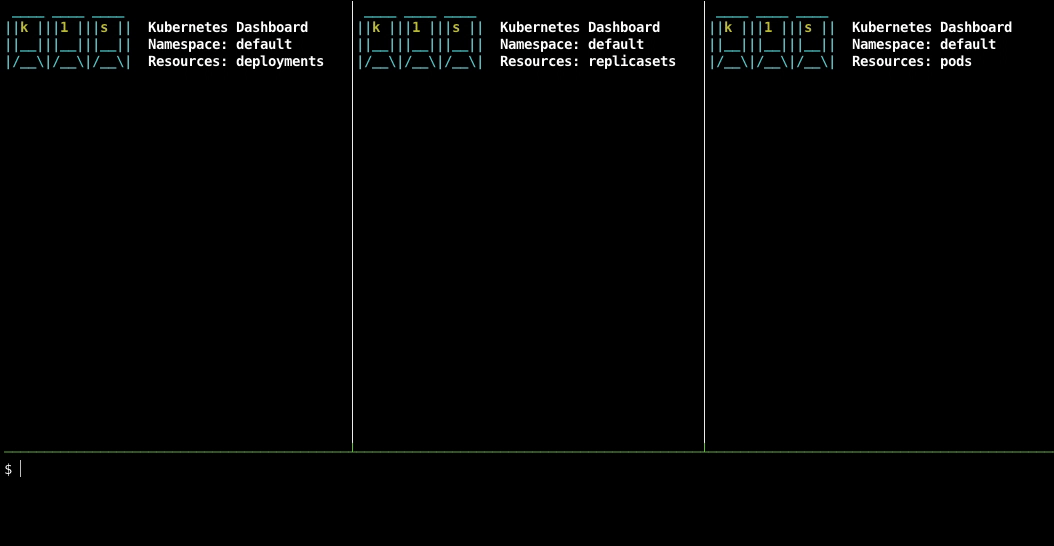https://github.com/weibeld/k1s
The world's simplest Kubernetes dashboard (50 lines of Bash code)
https://github.com/weibeld/k1s
bash kubernetes kubernetes-dashboard shell
Last synced: 18 days ago
JSON representation
The world's simplest Kubernetes dashboard (50 lines of Bash code)
- Host: GitHub
- URL: https://github.com/weibeld/k1s
- Owner: weibeld
- License: mit
- Created: 2020-04-21T16:01:16.000Z (about 5 years ago)
- Default Branch: master
- Last Pushed: 2022-12-29T19:01:04.000Z (over 2 years ago)
- Last Synced: 2025-03-24T10:56:25.504Z (about 1 month ago)
- Topics: bash, kubernetes, kubernetes-dashboard, shell
- Language: Shell
- Homepage:
- Size: 5.19 MB
- Stars: 237
- Watchers: 10
- Forks: 24
- Open Issues: 2
-
Metadata Files:
- Readme: README.md
- License: LICENSE
Awesome Lists containing this project
README
# k1s: The world's simplest Kubernetes dashboard
A minimalistic Kubernetes dashboard implemented with 50 lines of Bash code.

## Contents
1. [Introduction](#introduction)
1. [Installation](#installation)
1. [Usage](#usage)
1. [Examples](#examples)
## Introduction
### What is it?
A minimalistic Kubernetes dashboard showing the current state of Kubernetes resources of a specific type in real-time. The entire tool consists merely of a Bash script with about 50 lines of code.
### What is it not?
It's not a production-grade dashboard with many features. It's mainly intended for educational purposes.
### How does it work?
With a lot of highly condensed Bash scripting. [This article](https://itnext.io/the-worlds-simplest-kubernetes-dashboard-k1s-4246e03191df) explains how it works in detail.
## Installation
### On macOS
```bash
brew install weibeld/tap/k1s
```
### On other systems
Simply download the [`k1s`](k1s) script, make it executable, and move it to any directory in your `PATH`.
For example:
```bash
wget https://raw.githubusercontent.com/weibeld/k1s/master/k1s
chmod +x k1s
mv k1s /usr/local/bin
```
### Dependencies
The `k1s` script depends on the following tools:
#### [`jq`](https://stedolan.github.io/jq/)
| OS | Installation |
|-------|---------------------------|
| macOS | `brew install jq` |
| Linux | `sudo apt-get install jq` |
#### [`watch`](https://linux.die.net/man/1/watch)
| OS | Installation |
|-------|----------------------------|
| macOS | `brew install watch` |
| Linux | — _(installed by default)_ |
#### [`curl`](https://curl.haxx.se/)
| OS | Installation |
|-------|----------------------------|
| macOS | — _(installed by default)_ |
| Linux | sudo apt-get install curl |
#### [`kubectl`](https://kubernetes.io/docs/tasks/tools/install-kubectl/)
| OS | Installation |
|-------|---------------------------------------------------------------------|
| macOS | `brew install kubernetes-cli` |
| Linux | _See https://kubernetes.io/docs/tasks/tools/install-kubectl-linux/_ |
## Usage
k1s runs directly on your local machine and it uses the usual [kubeconfig](https://kubernetes.io/docs/concepts/configuration/organize-cluster-access-kubeconfig/) configuration on your machine. That means, it connects to the same cluster that also `kubectl` connects to by default.
The command-line interface is as follows:
```bash
k1s [] []
```
Both arguments are optional. The default values are:
| Argument | Default value |
|-------------------|---------------|
| `` | `default` |
| `` | `pods` |
The `` argument may be set to any valid namespace in the cluster. In addition, `` may be set to `-` to imply "all namespaces" for namespaced resource types and "no namespace" for non-namespaced resource types (e.g. ClusterRoles).
> You can find out which resource types are namespaced or non-namespaced with `kubectl api-resources --namespaced=true|false`.
The `` argument may be set to any valid resource type name (including their singular, plural and short forms).
> You can list all supported resource type names with `kubectl api-resources`.
To exit the dashboard, type _Ctrl-C_.
## Examples
Below is an example usage scenario for k1s. It uses multiple instances of k1s for observing what's going on under the hood when scaling a Deployment:

> Note how during the rolling update, you can observe how the replica count of the Deployment always stays within a certain range. You can influence this range with the [`maxSurge` and `maxUnavailable`](https://kubernetes.io/docs/concepts/workloads/controllers/deployment/#rolling-update-deployment) settings in the Deployment specification.
To recreate the above example, launch three instances of k1s in separate terminal windows (or in different [tmux](https://github.com/tmux/tmux/wiki) panes, as shown above):
```bash
k1s default deployments
```
```bash
k1s default replicasets
```
```bash
k1s default pods
```
Then, create a Deployment:
```bash
kubectl create deployment dep1 --image=nginx
```
Scale the Deployment:
```bash
kubectl scale deployment dep1 --replicas=10
```
Patch the Deployment with a new container image, which causes a rolling update:
```bash
kubectl patch deployment dep1 -p '{"spec":{"template":{"spec":{"containers":[{"name":"nginx","image":"nginx:1.19.0"}]}}}}'
```
> You can also manually edit the Deployment with `kubectl edit deployment dep1`.
Finally, delete the Deployment:
```bash
kubectl delete deployment dep1
```
### Advanced usage scenarios
Here's a list of more advanced usage scenarios contributed by users of k1s:
- [**mjbright/k1s-scenarios**](https://github.com/mjbright/k1s-scenarios) by Mike Bright
> If you want to have your work added, file an issue, or directly make a pull request with your link added to this list.